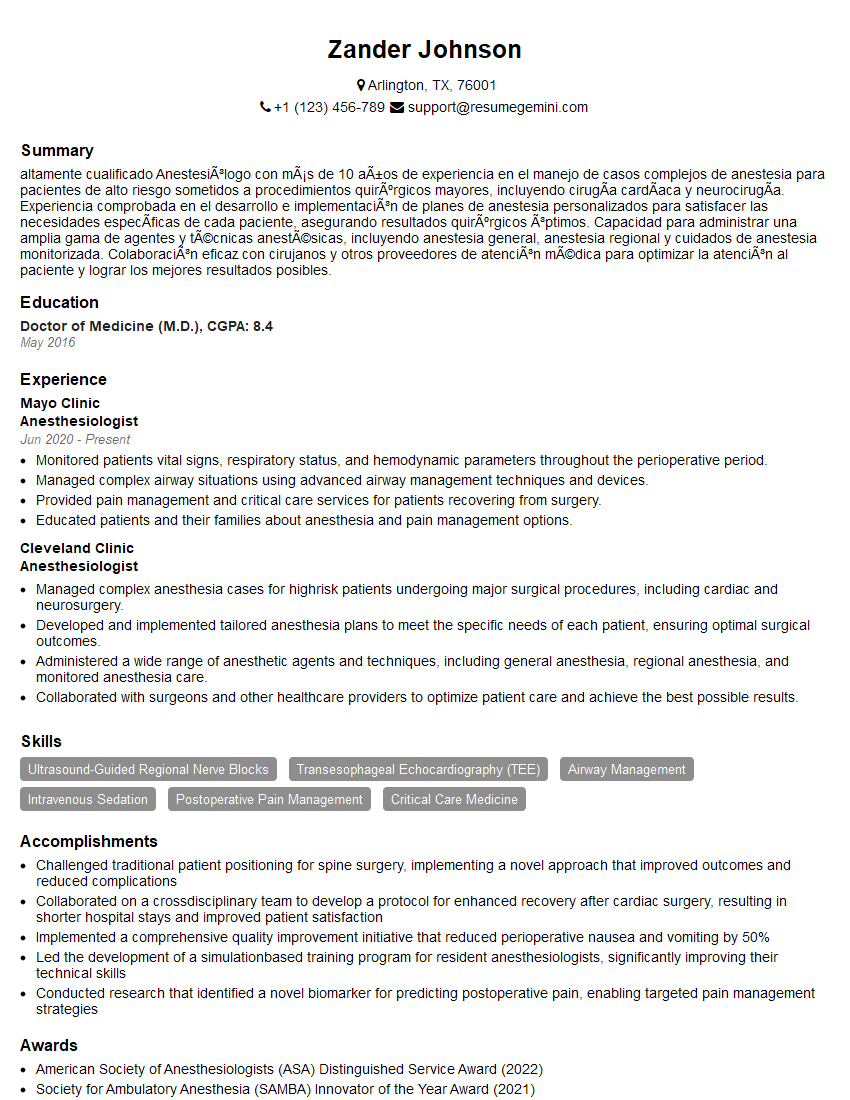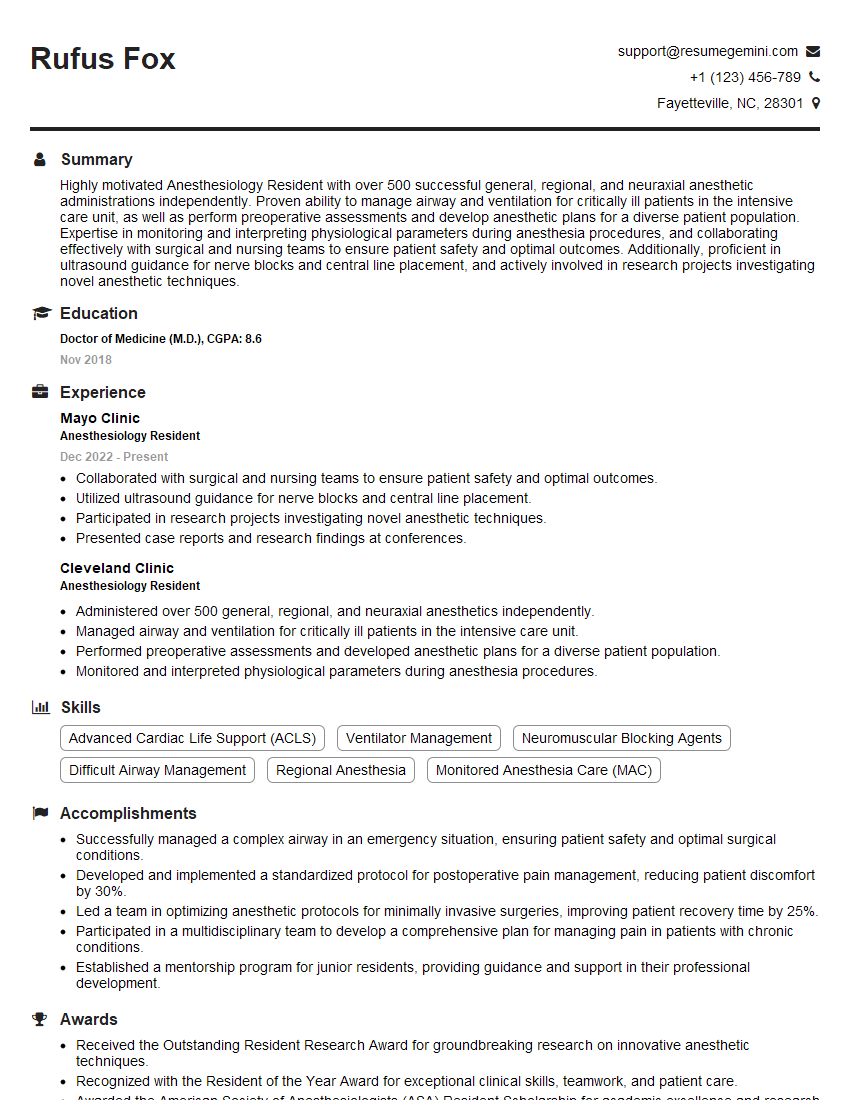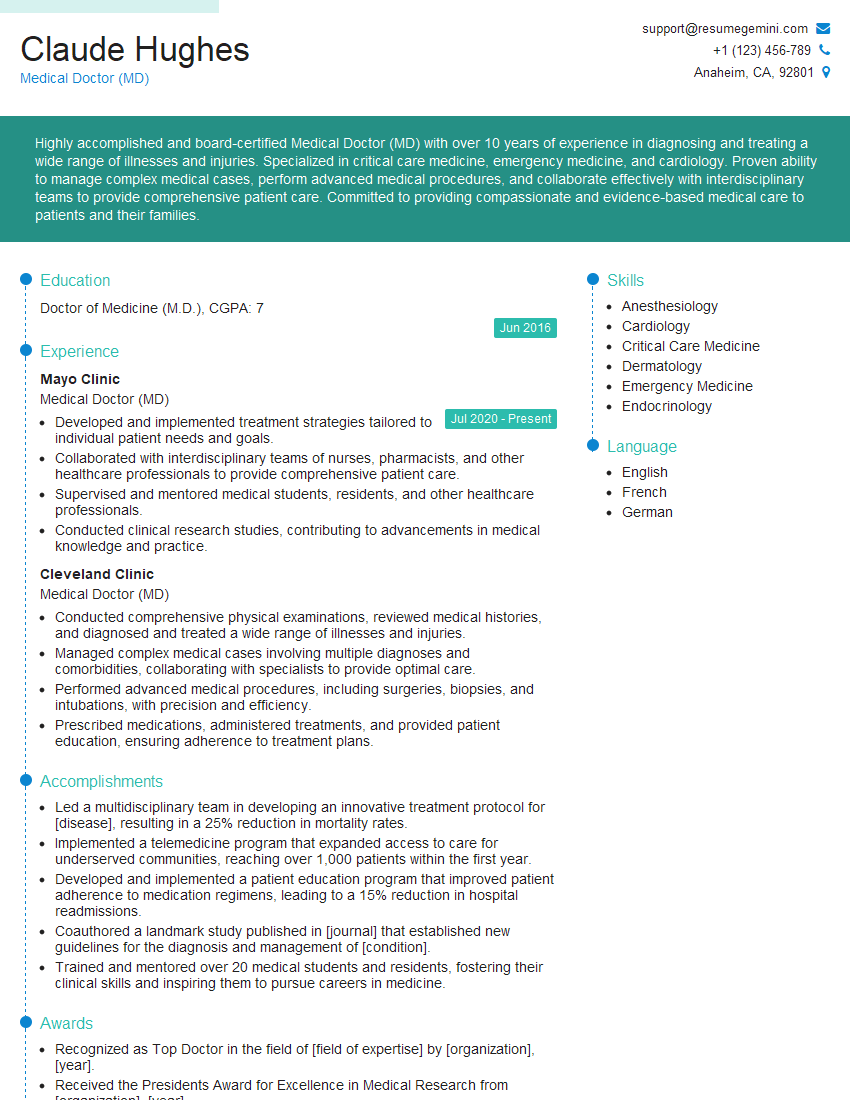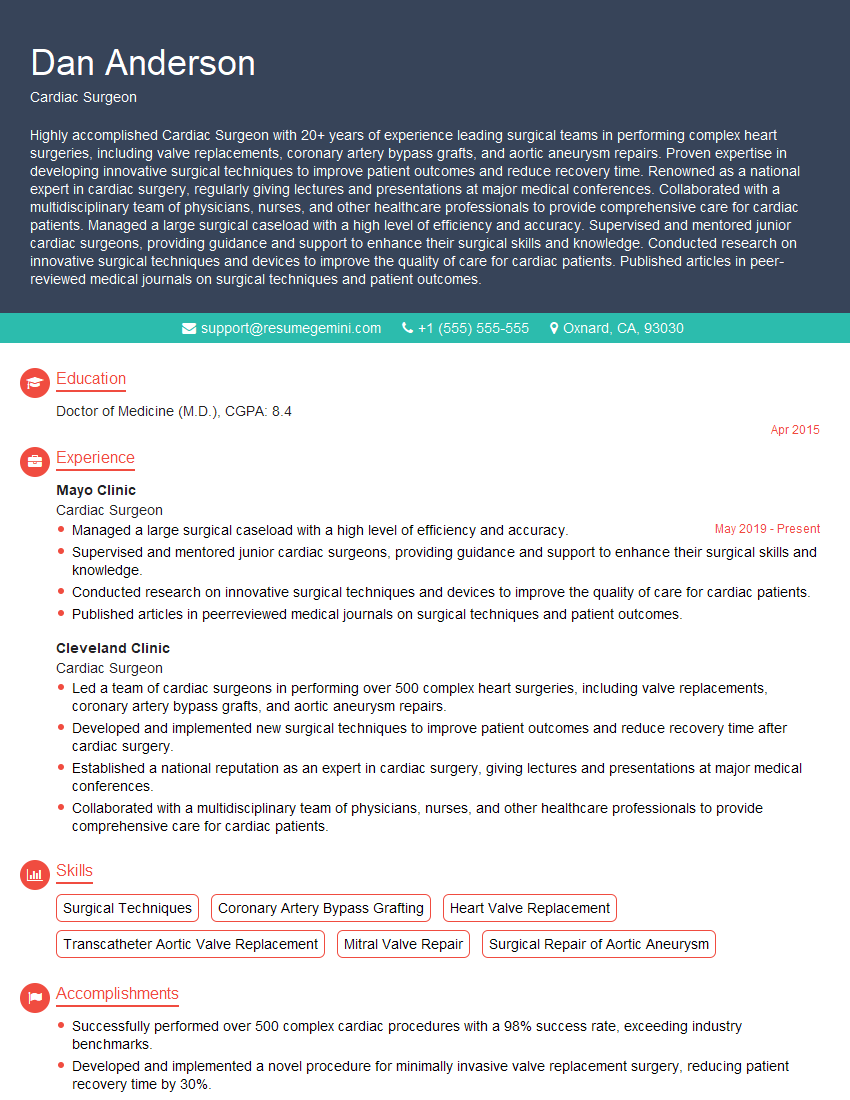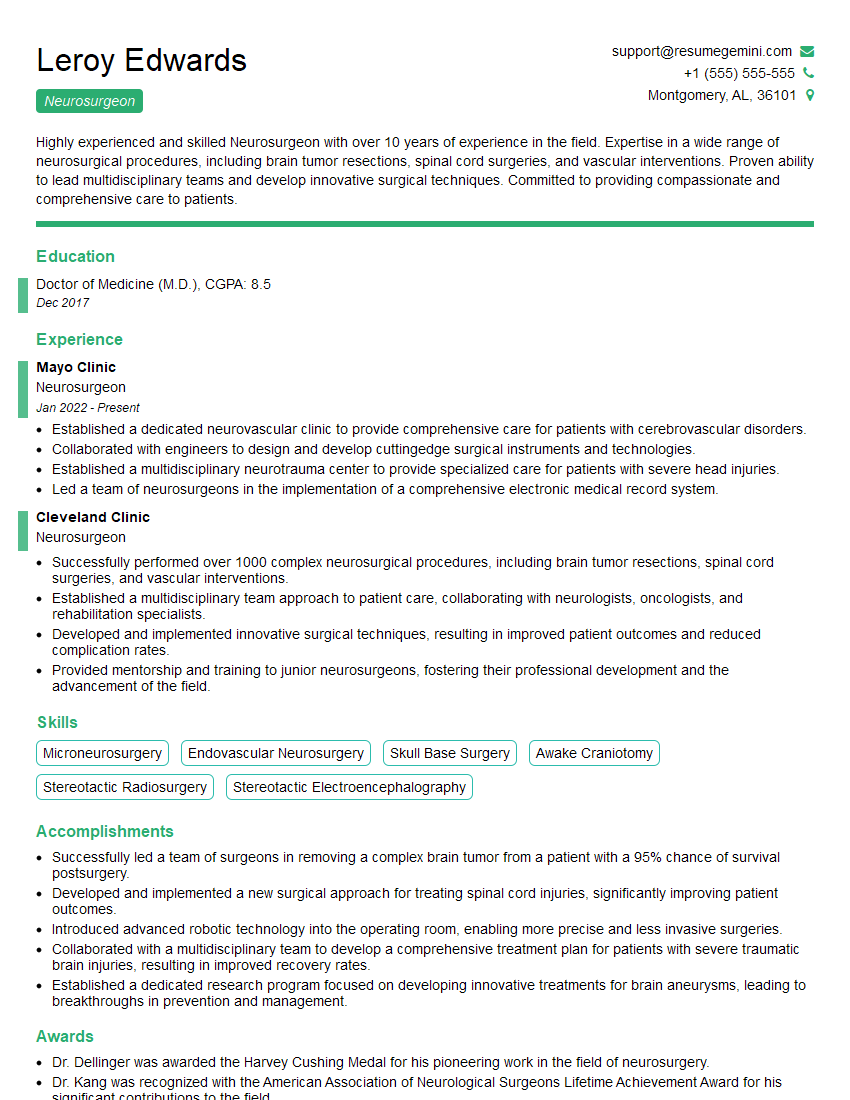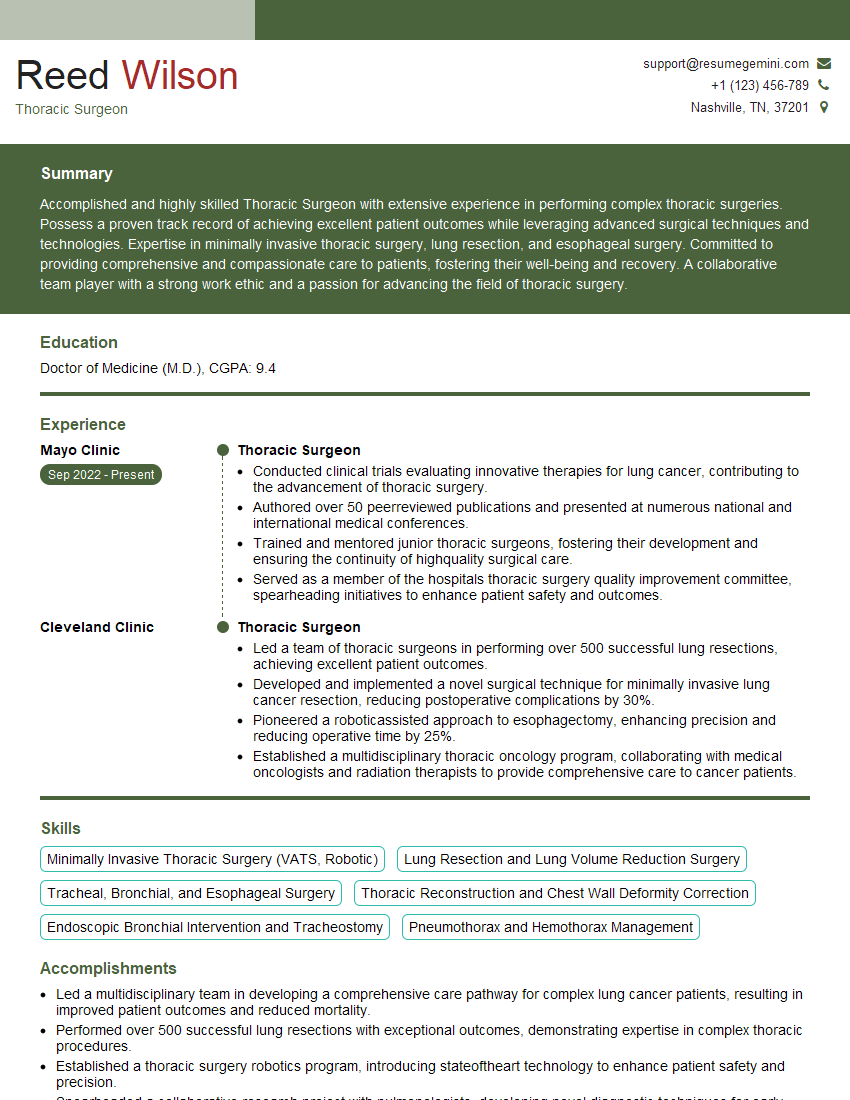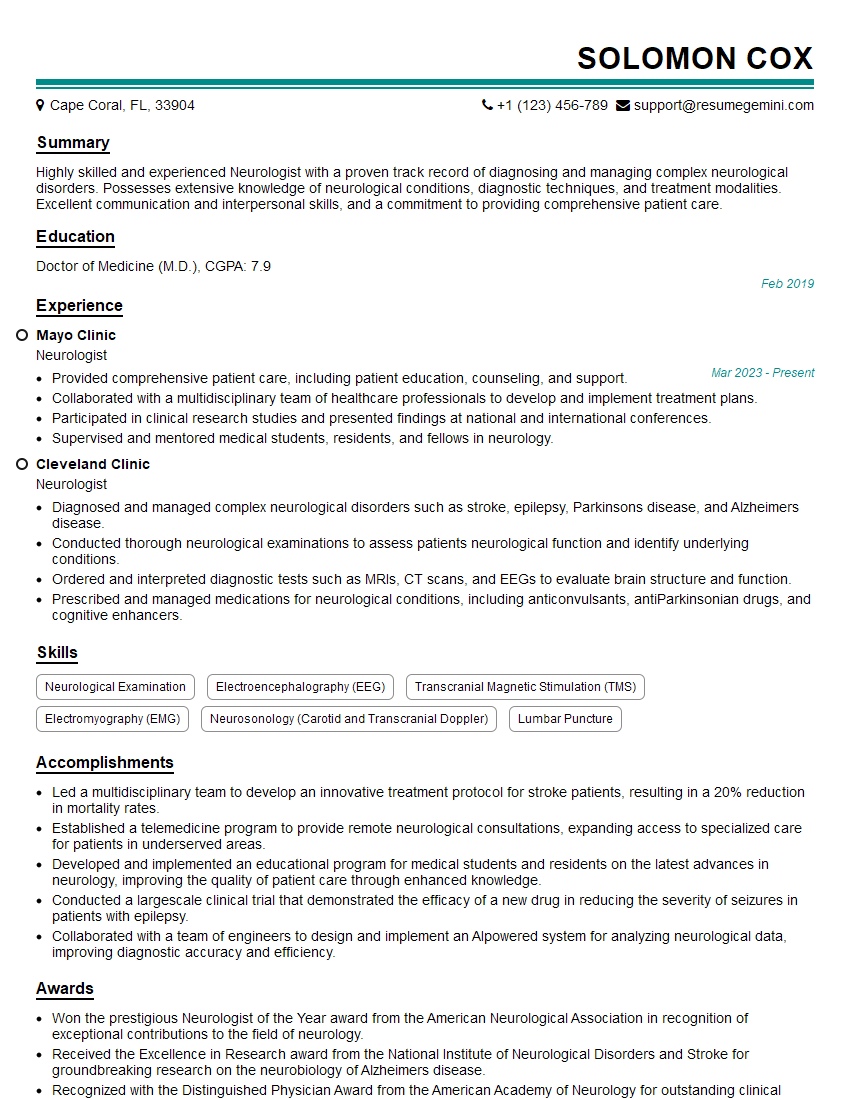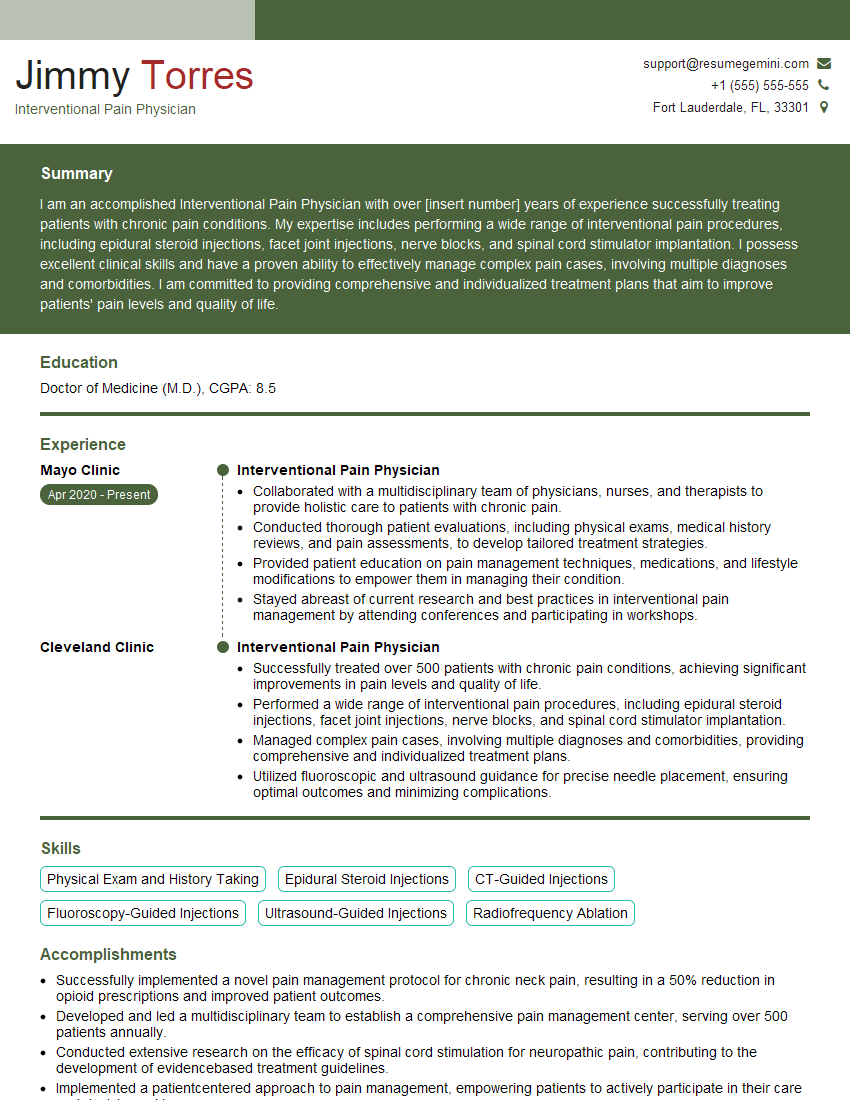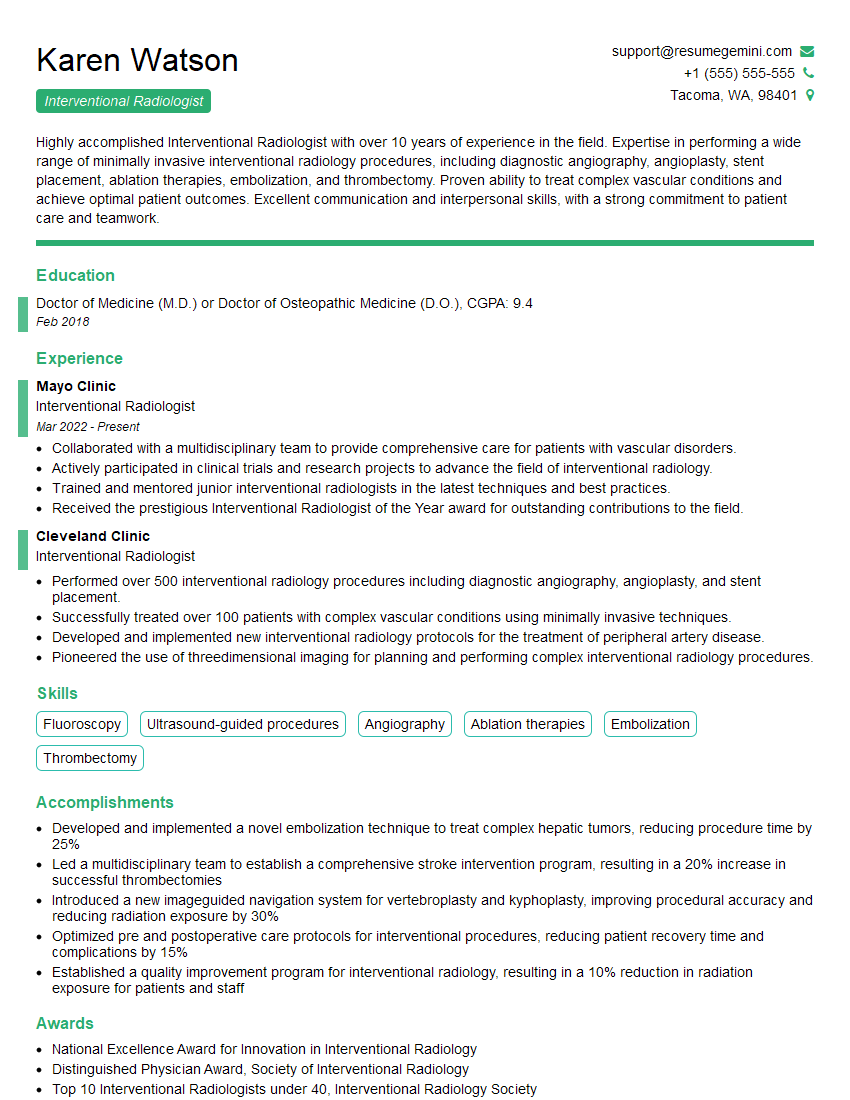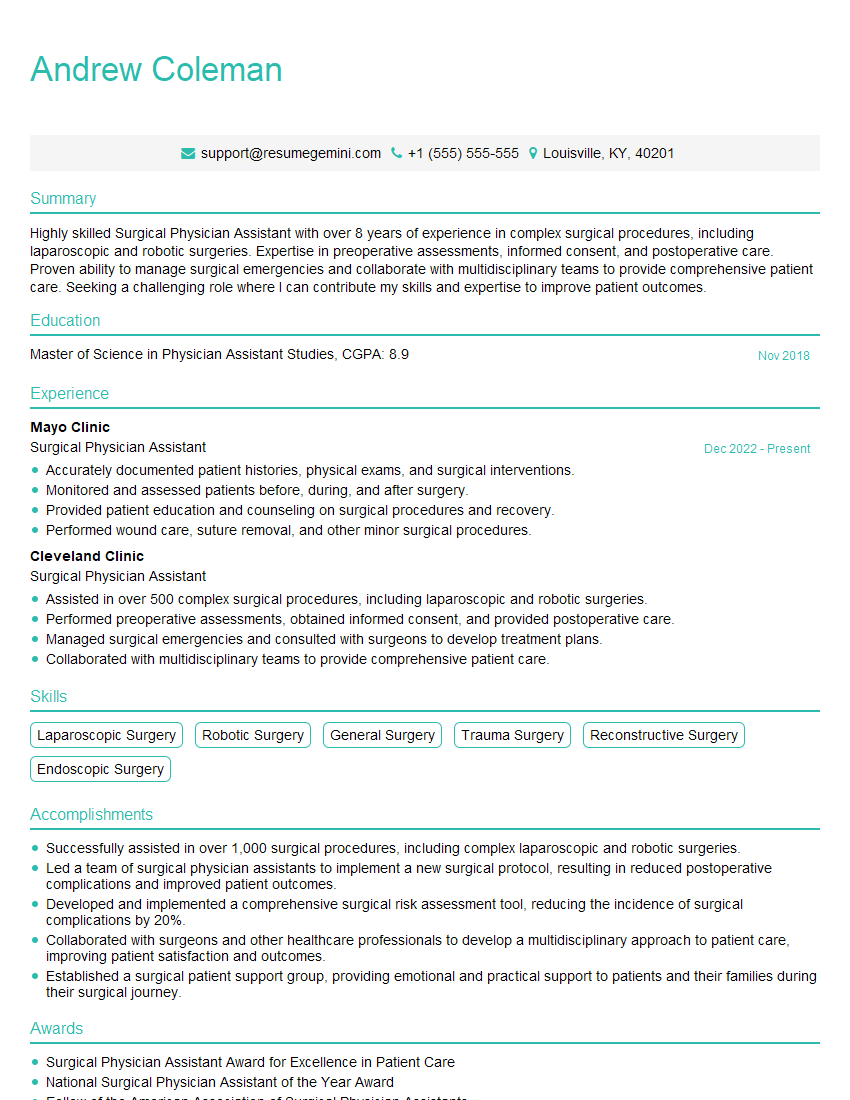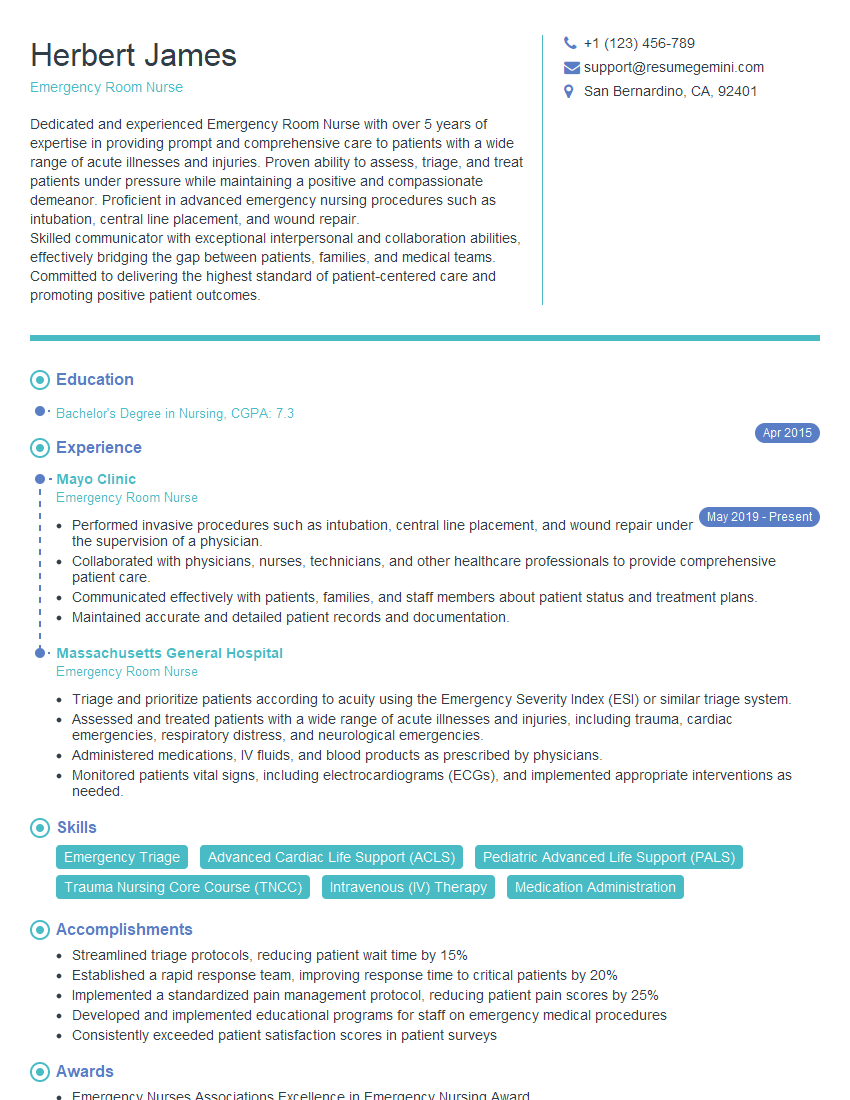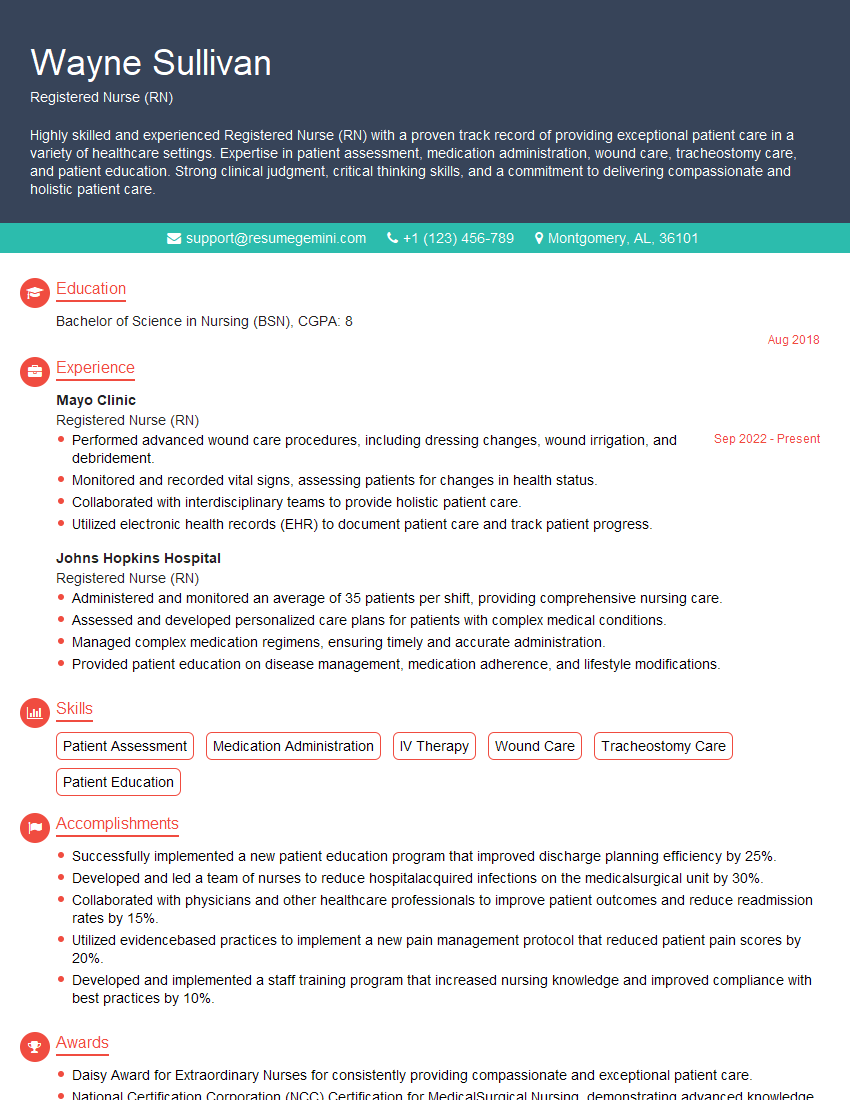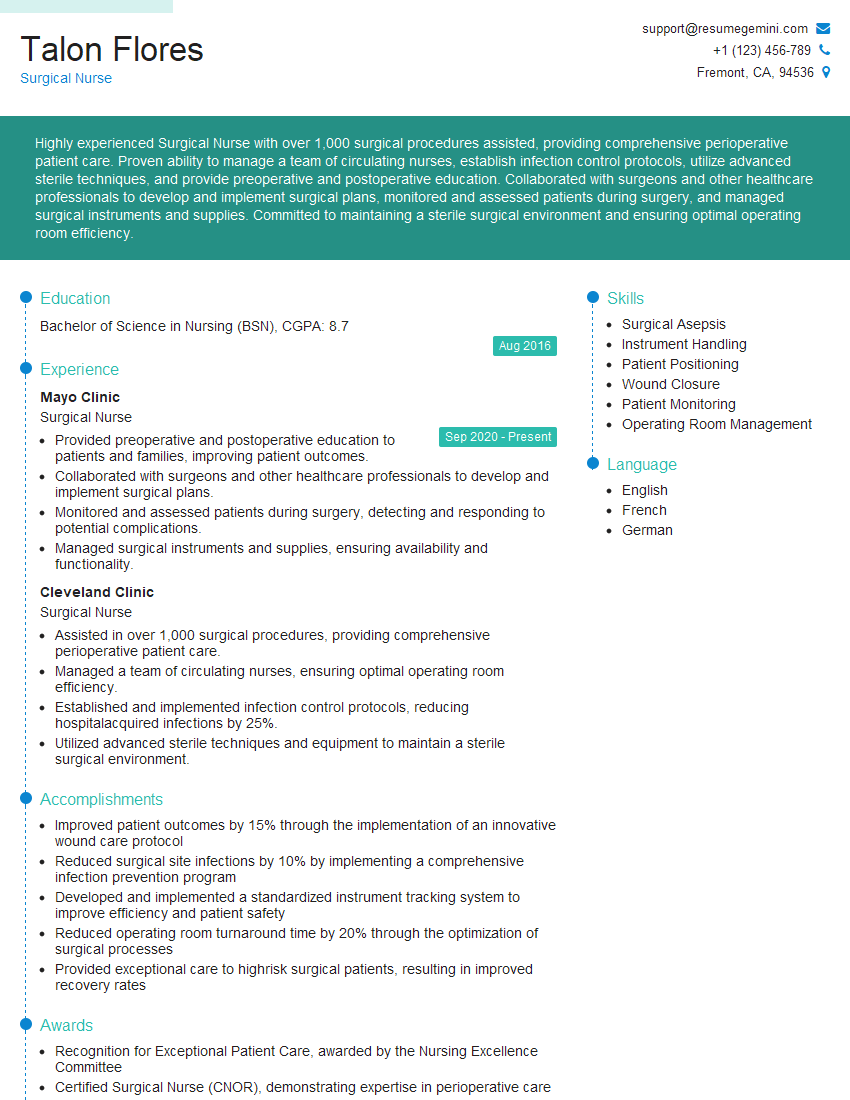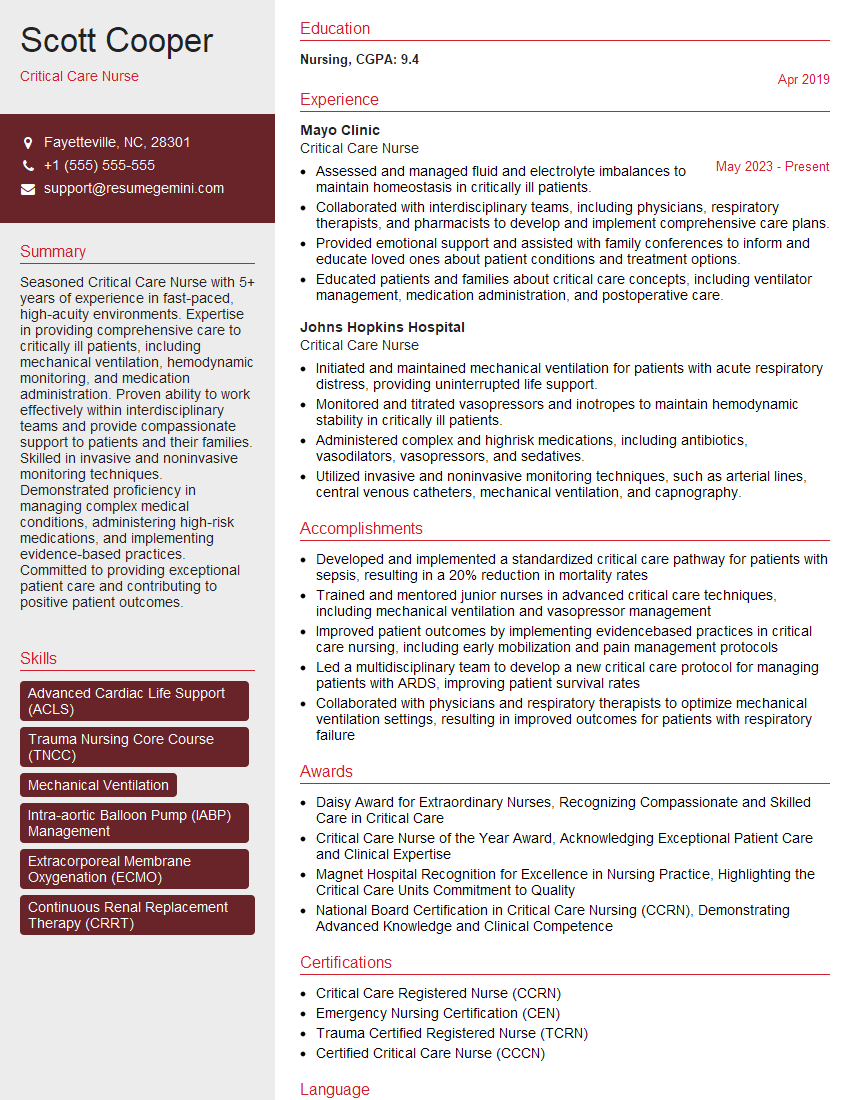Every successful interview starts with knowing what to expect. In this blog, we’ll take you through the top Intercostal Nerve Blocks interview questions, breaking them down with expert tips to help you deliver impactful answers. Step into your next interview fully prepared and ready to succeed.
Questions Asked in Intercostal Nerve Blocks Interview
Q 1. Describe the anatomical landmarks used for performing an intercostal nerve block.
Identifying the correct anatomical landmarks is crucial for a successful and safe intercostal nerve block. We primarily rely on palpation and anatomical knowledge. Imagine the rib cage as a series of stacked ribs. The intercostal space is the area between two adjacent ribs.
- Ribs: We can easily palpate the ribs, using our fingers to count down from the vertebra prominens (the most prominent bony landmark at the base of the neck) to reach the desired intercostal space.
- Intercostal Spaces: The targeted intercostal space is determined based on the location of the pain or surgical site. For example, a block for post-thoracotomy pain would target the intercostal spaces of the thoracic incision.
- Costal Angle: The costal angle, where the ribs meet the costal cartilage, offers an additional reference point, particularly for identifying the inferior margin of the rib above the target intercostal space.
- Vertebral Column: The spinous processes of the vertebrae are helpful in estimating the location of the paravertebral space.
Using these landmarks, we can accurately locate the intercostal space and subsequently inject the local anesthetic near the nerve.
Q 2. What are the different approaches to performing an intercostal nerve block?
There are several approaches to performing an intercostal nerve block, each with its own advantages and disadvantages. The choice of approach depends on factors such as the patient’s anatomy, the location of the target nerve, and the physician’s preference.
- Paravertebral Approach: This is the most common approach. The needle is inserted near the vertebral bodies and advanced medially towards the intercostal space, aiming for the paravertebral space where the nerves run. It has a higher success rate for multi-level nerve block but also a higher risk of pneumothorax.
- Intercostal Approach: The needle is inserted directly into the intercostal space, typically near the superior aspect of the rib below the target intercostal space. This approach is less likely to cause a pneumothorax but might only block a single intercostal nerve.
- Subcostal Approach: In some instances, this is chosen to target the lowest nerves. The needle goes under the rib towards the intercostal space.
It’s important to note that ultrasound guidance is increasingly utilized to enhance accuracy and reduce complications with all approaches.
Q 3. Explain the mechanism of action of an intercostal nerve block.
The mechanism of action is straightforward: the local anesthetic, typically bupivacaine or ropivacaine, blocks the transmission of nerve impulses within the intercostal nerves.
The local anesthetic works by binding to voltage-gated sodium channels in the nerve membranes. This prevents the influx of sodium ions, which are essential for the generation and propagation of action potentials. In simple terms, it temporarily ‘deadens’ the nerve, preventing pain signals from reaching the brain.
The effectiveness and duration of the block depend on various factors including the local anesthetic chosen, the concentration used, and the volume of the anesthetic injected. The spread of the local anesthetic around the nerve also influences the extent and duration of the block.
Q 4. What are the indications for performing an intercostal nerve block?
Intercostal nerve blocks are valuable in several clinical scenarios because of their ability to provide effective analgesia to the chest wall.
- Post-thoracotomy pain: This is a primary indication, offering significant pain relief following chest surgery.
- Rib fractures: The block provides excellent pain management for fractured ribs, reducing the need for opioid analgesics.
- Herpes zoster (shingles): It can provide substantial pain relief for the neuralgic pain associated with shingles.
- Chest trauma: For chest wall pain following trauma.
- Pleurocentesis/Thoracentesis: These procedures can be made more comfortable by performing a regional intercostal nerve block first.
The precise indication for a block is determined by a careful clinical assessment of the patient’s needs and the risks involved.
Q 5. What are the contraindications for performing an intercostal nerve block?
While generally safe, there are situations where an intercostal nerve block might not be advisable.
- Coagulopathy: Patients with bleeding disorders are at increased risk of hematoma formation at the injection site.
- Infection at the injection site: Introducing a needle into an infected area can spread infection.
- Patient refusal: Informed consent is crucial. A patient’s refusal to undergo the procedure must be respected.
- Allergy to local anesthetic: Any known allergy to local anesthetics would be a contraindication.
- Severe respiratory compromise: The risk of pneumothorax is already present; existing respiratory issues increase this risk considerably.
A thorough assessment of the patient’s history and current condition is necessary to identify any contraindications.
Q 6. List the potential complications associated with intercostal nerve blocks.
While relatively safe, intercostal nerve blocks are associated with a few potential complications.
- Pneumothorax: This is the most serious complication, involving a collapsed lung due to inadvertent puncture of the pleura. This is a medical emergency.
- Hematoma: Bleeding at the injection site can occur, particularly in patients with bleeding disorders.
- Infection: Infection is possible, although less common with proper aseptic technique.
- Nerve damage: Injury to the intercostal nerve or other nerves is rare but possible.
- Local anesthetic toxicity: This is rare with proper dosing and technique but can occur with accidental intravascular injection.
It is important to be well-versed in the recognition and management of these potential complications.
Q 7. How do you manage pneumothorax as a complication of an intercostal nerve block?
Managing a pneumothorax following an intercostal nerve block requires immediate attention as it’s a life-threatening complication.
The initial steps involve:
- Assess the patient: Monitor respiratory status, oxygen saturation, and vital signs.
- Supplemental oxygen: Administer high-flow oxygen via a face mask.
- Chest X-ray: Confirm the diagnosis and determine the size and severity of the pneumothorax.
- Thoracentesis: In some cases, a needle thoracostomy may be performed to remove air from the pleural space. This is often followed by a chest tube placement for more complete drainage.
- Chest tube insertion: This is typically the definitive management for a pneumothorax, allowing for drainage of the air and lung re-expansion.
Close monitoring of the patient’s respiratory status and prompt intervention are crucial for successful management. In severe cases, surgical intervention may be necessary.
Q 8. What are the common local anesthetics used in intercostal nerve blocks?
Several local anesthetics are commonly used for intercostal nerve blocks, chosen based on factors like the duration of analgesia needed and patient-specific factors. The most frequently employed are:
- Bupivacaine: A long-acting amide local anesthetic, often preferred for its extended duration of action, useful for post-operative pain management.
- Ropivacaine: Similar to bupivacaine, but generally considered to have a slightly lower cardiotoxicity profile. Also a long-acting agent.
- Lidocaine: A shorter-acting amide local anesthetic; sometimes used in combination with longer-acting agents or when a shorter duration of analgesia is sufficient.
- Chloroprocaine: A rapidly metabolized ester local anesthetic, offering a short duration of action and minimizing systemic effects.
The choice depends on the specific clinical situation and the desired duration of the block. For example, bupivacaine might be ideal for post-thoracotomy pain, while lidocaine might be suitable for a shorter procedure.
Q 9. How do you select the appropriate concentration and volume of local anesthetic for an intercostal nerve block?
Selecting the appropriate concentration and volume of local anesthetic is crucial for effective pain relief while minimizing systemic toxicity. The concentration typically ranges from 0.25% to 0.5% for bupivacaine or ropivacaine, and slightly higher for lidocaine. The volume is determined by the number of intercostal spaces to be blocked; usually, 3-5 ml per intercostal space is sufficient.
Factors influencing this decision include:
- The extent of the surgical procedure: A larger surgical area will likely require a larger volume.
- Patient characteristics: Age, weight, and overall health status are considered to minimize the risk of systemic toxicity.
- The presence of any contraindications: For example, patients with pre-existing cardiac conditions may require lower concentrations.
A careful assessment is vital. Underdosing will result in inadequate analgesia, while overdosing could lead to systemic toxicity, including cardiac arrhythmias or seizures. Therefore, meticulous calculation and careful patient monitoring are essential.
Q 10. Describe the technique for performing an ultrasound-guided intercostal nerve block.
Ultrasound-guided intercostal nerve blocks offer improved accuracy and reduced complications compared to blind techniques. Here’s a step-by-step description:
- Patient Positioning and Preparation: The patient is positioned comfortably, with the area to be blocked prepped and draped in sterile fashion.
- Ultrasound Probe Placement: An ultrasound probe is placed in the intercostal space, typically in a transverse plane, visualizing the intercostal muscles, pleura, and the intercostal nerve.
- Nerve Identification: The intercostal nerve is identified as a hypoechoic structure running between the internal and innermost intercostal muscles.
- Needle Insertion: A small-gauge needle (typically 22-25 gauge) is advanced in-plane or out-of-plane, guided by real-time ultrasound visualization, towards the intercostal nerve.
- Local Anesthetic Injection: Once the needle is appropriately positioned, the local anesthetic is injected slowly, while continuously monitoring for any signs of intrathecal or intravascular injection. Hydrostatic pressure changes, characteristic of vascular puncture, should be avoided.
- Confirmation and Spread: Ultrasound is used to confirm the spread of the local anesthetic around the nerve.
Throughout the procedure, close attention is paid to the patient’s vital signs, to ensure any potential complications are detected early.
Q 11. How do you manage pain during an intercostal nerve block procedure?
Pain management during an intercostal nerve block is crucial for patient comfort and procedural success. We employ several strategies:
- Topical Anesthesia: Applying a topical anesthetic cream (like lidocaine 5%) to the skin 30-60 minutes prior to the procedure numbs the skin and reduces initial needle-related discomfort.
- Short-Acting Sedatives/Analgesics: In some cases, a short-acting sedative or analgesic like midazolam or fentanyl may be administered intravenously to alleviate anxiety and further reduce pain during the procedure. These should be used judiciously and under close monitoring.
- Slow Injection Technique: Injecting the local anesthetic slowly minimizes the discomfort associated with injection.
Communication with the patient is paramount. Explaining each step of the procedure and reassuring the patient can significantly reduce anxiety and improve their experience.
Q 12. What are the advantages and disadvantages of using ultrasound guidance for intercostal nerve blocks?
Ultrasound guidance for intercostal nerve blocks offers significant advantages, but also comes with some disadvantages:
Advantages:
- Increased Accuracy: Ultrasound provides real-time visualization, enabling precise needle placement and minimizing the risk of pneumothorax (collapsed lung) or intravascular injection.
- Reduced Complications: The enhanced accuracy translates to fewer complications, including failed blocks and systemic toxicity.
- Lower Anesthetic Volume: Precise targeting often allows for the use of smaller volumes of local anesthetic.
Disadvantages:
- Learning Curve: Mastering the ultrasound technique requires specialized training and practice.
- Cost: Ultrasound machines and related equipment represent a significant investment.
- Time: Ultrasound-guided blocks generally take longer to perform than blind blocks.
Despite the disadvantages, the overall benefits of improved safety and efficacy generally outweigh the drawbacks, especially in experienced hands.
Q 13. Describe the use of nerve stimulators in intercostal nerve blocks.
Nerve stimulators can be used in conjunction with or as an alternative to ultrasound guidance. A nerve stimulator is a device that delivers small electrical impulses to the nerve, causing a muscle twitch. This twitch confirms that the needle is near the nerve.
The technique involves placing the needle near the suspected location of the intercostal nerve. Small electrical pulses are delivered through the needle; a muscle twitch in the corresponding intercostal muscle confirms proximity to the nerve. Once a twitch is elicited, a small amount of local anesthetic is injected.
However, nerve stimulators are not as precise as ultrasound, and they may not always accurately identify the nerve. They’re generally less preferred now in favor of ultrasound guidance.
Q 14. How do you assess the effectiveness of an intercostal nerve block?
Assessing the effectiveness of an intercostal nerve block involves a combination of objective and subjective measures.
- Pain Score: The patient’s pain level is assessed using a validated pain scale, such as the numerical rating scale (NRS) or the visual analog scale (VAS). A significant reduction in pain scores after the block indicates effectiveness.
- Respiratory Function: Respiratory rate, depth, and oxygen saturation are monitored, as compromised respiratory function could indicate a complication like pneumothorax.
- Motor Function: Motor function in the relevant intercostal muscles is assessed to ensure the block hasn’t caused unintended paralysis.
- Patient Assessment: The patient’s subjective report of pain relief, along with their ability to cough, deep breathe, and move without significant pain are key indicators of a successful block.
A combination of these assessments ensures a comprehensive evaluation of the block’s effectiveness and the overall well-being of the patient.
Q 15. What are the alternative techniques to intercostal nerve blocks for managing chest wall pain?
Managing chest wall pain doesn’t solely rely on intercostal nerve blocks. Several alternative techniques exist, each with its own strengths and weaknesses. The choice depends on the patient’s specific condition, pain characteristics, and overall health.
- Epidural analgesia: This involves injecting medication into the epidural space of the spine, providing broader pain relief across multiple dermatomes, including the chest wall. It’s particularly useful for post-surgical pain or conditions affecting larger areas.
- Paravertebral blocks: These target the nerve roots before they branch into intercostal nerves, offering a more proximal and potentially longer-lasting effect compared to individual intercostal blocks. (We’ll discuss this further in the next question).
- Transcutaneous electrical nerve stimulation (TENS): A non-invasive method using electrodes placed on the skin to deliver electrical impulses, which can modulate pain signals. It’s often used as an adjunct therapy or for milder pain.
- Pharmacological management: Oral or intravenous analgesics, including NSAIDs, opioids, and adjuvant medications (e.g., antidepressants, anticonvulsants), play a crucial role in pain management, often used in combination with other techniques.
- Physical therapy: This focuses on improving posture, strengthening muscles, and increasing mobility to alleviate pain and improve overall function. It’s particularly helpful for chronic chest wall pain.
For example, a patient with post-thoracotomy pain might benefit from a combination of epidural analgesia and physical therapy, while a patient with localized pain from shingles might find relief with a series of intercostal nerve blocks supplemented by oral analgesics.
Career Expert Tips:
- Ace those interviews! Prepare effectively by reviewing the Top 50 Most Common Interview Questions on ResumeGemini.
- Navigate your job search with confidence! Explore a wide range of Career Tips on ResumeGemini. Learn about common challenges and recommendations to overcome them.
- Craft the perfect resume! Master the Art of Resume Writing with ResumeGemini’s guide. Showcase your unique qualifications and achievements effectively.
- Don’t miss out on holiday savings! Build your dream resume with ResumeGemini’s ATS optimized templates.
Q 16. Explain the concept of paravertebral block and its relation to intercostal blocks.
A paravertebral block targets the sympathetic chain and the dorsal rami of the spinal nerves at the level of the vertebrae. Unlike an intercostal nerve block which targets individual intercostal nerves at the level of the ribs, a paravertebral block offers a more proximal blockade. This means it affects a larger area, encompassing multiple intercostal nerves. Imagine it like this: intercostal blocks are like targeting individual branches of a tree, while paravertebral blocks are like targeting the main trunk.
The relationship is that a paravertebral block can achieve a similar analgesic effect to multiple intercostal nerve blocks, often with fewer injections. However, paravertebral blocks also carry a risk of affecting sympathetic nerves, potentially leading to side effects such as hypotension or Horner’s syndrome. Intercostal blocks are more localized and generally have a lower risk of systemic side effects.
Clinically, the choice between the two depends on the extent and location of the pain. For instance, widespread chest wall pain might be better addressed with a paravertebral block, while localized pain from a specific injury might be effectively managed with an intercostal block.
Q 17. What are the differences between a single and multi-level intercostal block?
The difference lies primarily in the number of intercostal nerves targeted. A single-level intercostal block involves injecting local anesthetic around a single intercostal nerve, typically for localized pain at a specific segment. A multi-level intercostal block, on the other hand, involves injecting local anesthetic around several intercostal nerves, spanning multiple segments of the chest wall. This is used when the pain is widespread or involves multiple intercostal spaces.
For instance, a patient with post-herpetic neuralgia affecting only the fourth intercostal space might receive a single-level block at T4. Conversely, a patient with significant post-thoracotomy pain might require a multi-level block encompassing multiple intercostal spaces, perhaps from T3 to T7. The choice depends on the clinical scenario and the extent of the pain.
Q 18. How do you manage a patient who develops a systemic toxic reaction to local anesthetic?
Managing a systemic toxic reaction to local anesthetic requires immediate and decisive action. The severity of the reaction can range from mild (e.g., nausea, dizziness) to severe (e.g., seizures, cardiovascular collapse), dictating the urgency and intensity of the response. The ABCs of resuscitation—Airway, Breathing, and Circulation—take precedence.
- Secure the airway: If the patient is seizing or losing consciousness, immediate airway management is crucial, which may involve intubation and mechanical ventilation.
- Support respiration: Oxygen supplementation is essential. If respiratory compromise is present, assisted ventilation may be necessary.
- Address circulatory issues: Monitor vital signs continuously. Hypotension requires fluid resuscitation, possibly with vasopressors. Tachycardia may need treatment with beta-blockers.
- Treat seizures: If seizures occur, administer anticonvulsants like diazepam or propofol intravenously.
- Monitor for other complications: Cardiac rhythm abnormalities, metabolic acidosis, and other organ system dysfunctions need prompt identification and management.
Following stabilization, supportive care is vital, which might include close monitoring in an intensive care unit. Detailed documentation of the reaction, treatment provided, and the patient’s response is essential for future reference and learning.
Q 19. What are the long-term complications of intercostal nerve blocks?
While generally safe, long-term complications from intercostal nerve blocks are relatively uncommon but possible. They can include:
- Persistent pain or paresthesia: In rare cases, the block itself can lead to persistent pain or unusual sensations in the affected area. This is more likely with improper technique or nerve injury.
- Infection: Though rare with proper aseptic technique, infection at the injection site is a potential complication.
- Nerve damage: Accidental damage to the intercostal nerve or other adjacent structures during the procedure can lead to long-term motor or sensory deficits. This is minimized by proper technique and ultrasound guidance.
- Hematoma formation: Bleeding at the injection site can occur, particularly in patients with bleeding disorders or anticoagulant therapy.
It’s important to emphasize that these complications are rare, and the benefits of the procedure usually outweigh the risks. Pre-procedural assessment, careful technique, and appropriate patient selection are essential for minimizing these risks.
Q 20. Discuss the role of pre-procedural patient education in intercostal nerve blocks.
Pre-procedural patient education is paramount for a successful and anxiety-free experience. It builds trust and allows patients to actively participate in their care. Key aspects include:
- Explaining the procedure: Describe the block’s purpose, technique (including use of ultrasound, if applicable), expected sensations during and after the procedure, and potential benefits and risks in plain language.
- Addressing concerns: Allow ample time for questions and patiently address any anxieties or fears the patient may have. This helps establish a rapport and foster a sense of comfort.
- Outlining potential complications: Transparent communication about potential side effects (including those that are rare) is critical for informed consent. Emphasize that serious complications are uncommon but possible.
- Describing post-procedure care: Explain any necessary restrictions or post-procedure care instructions, such as monitoring for bleeding, signs of infection, or changes in pain levels.
For instance, you might explain that the needle insertion may cause a brief stinging sensation, followed by numbness in the targeted area. Emphasizing that the patient can communicate any discomfort or concerns during the procedure helps create a positive experience.
Q 21. How do you document the intercostal nerve block procedure?
Meticulous documentation is crucial for legal, medical, and research purposes. It should include:
- Patient demographics: Name, date of birth, medical record number, etc.
- Indication for the block: Clearly state the reason for the procedure (e.g., post-surgical pain, herpetic neuralgia).
- Level(s) of intercostal nerve(s) blocked: Specify the intercostal spaces targeted.
- Type and amount of local anesthetic used: Record the name of the anesthetic, concentration, and volume administered.
- Technique used: Note whether ultrasound guidance was used, the approach (e.g., anterior, lateral), and any challenges encountered.
- Procedural findings: Describe any observations made during the procedure (e.g., bleeding, difficulty in identifying the nerve).
- Post-procedural assessment: Record the patient’s vital signs, pain level, and any immediate adverse events.
- Follow-up plan: Outline any planned post-procedure follow-up or subsequent blocks.
Clear, concise, and accurate documentation protects both the patient and the clinician, ensuring continuity of care and serving as a valuable record for future reference.
Q 22. What are the relevant legal and ethical considerations of performing intercostal nerve blocks?
Performing intercostal nerve blocks involves several crucial legal and ethical considerations. Primarily, informed consent is paramount. This means the patient must fully understand the procedure, its benefits, risks (including pneumothorax, bleeding, infection, nerve damage), and potential alternatives. This understanding should be documented meticulously. The physician must ensure the patient has the capacity to consent – meaning they are of sound mind and capable of making decisions for themselves.
Legally, adherence to relevant medical regulations and standards of practice is essential. This includes proper documentation, following established protocols for sterile technique, and appropriate post-procedural monitoring. Any complications must be documented accurately and reported as per institutional and legal requirements. We must also consider issues of patient privacy and confidentiality, strictly adhering to HIPAA or equivalent regulations, ensuring all patient data is handled securely.
Ethically, the procedure should always be medically justified, prioritizing patient benefit. The potential risks must be carefully weighed against the expected benefits. When uncertainty exists, it’s vital to discuss these risks openly with the patient and potentially seek a second opinion to ensure a fully ethical approach.
Q 23. Describe the use of continuous intercostal nerve blocks.
Continuous intercostal nerve blocks provide prolonged analgesia, unlike single-injection blocks. A catheter is placed near the intercostal nerve, allowing for continuous infusion of local anesthetic. This technique is particularly beneficial for managing post-surgical pain, especially after thoracotomy or rib fractures. The prolonged pain relief can significantly improve patient comfort, reduce the need for opioid analgesics, and facilitate faster recovery.
The procedure involves the insertion of a small catheter, usually through a needle, near the targeted intercostal nerve. This is usually done under fluoroscopic guidance for accuracy. Once in place, the catheter is connected to an infusion pump, delivering a continuous supply of local anesthetic. The rate of infusion is carefully adjusted according to the patient’s response and pain level. Regular monitoring is vital to ensure the catheter remains in place and is functioning correctly. The advantages include reduced pain, lower opioid requirements, and improved mobility. However, it also carries the risk of catheter migration or infection, requiring close monitoring.
Q 24. What are the specific challenges in performing intercostal nerve blocks in obese patients?
Obese patients present unique challenges during intercostal nerve blocks. The increased adipose tissue makes locating the intercostal spaces and nerves significantly more difficult. The added tissue depth can necessitate longer needles and increase the risk of tissue trauma or inadvertent injury to other structures. Accurate needle placement becomes more challenging, potentially leading to an ineffective block or increased risk of complications.
Visualization of the intercostal spaces using ultrasound guidance is often crucial in obese patients. Ultrasound allows for real-time visualization of the needle’s path and reduces the reliance on anatomical landmarks which can be obscured by the excess adipose tissue. Using smaller gauge needles to reduce trauma and selecting appropriately longer needles for sufficient reach are also important considerations. A multidisciplinary approach, involving skilled anesthesiologists and imaging specialists, might be necessary to optimize safety and efficacy in these cases.
Q 25. Discuss the role of monitoring during an intercostal nerve block procedure.
Monitoring during an intercostal nerve block is critical for patient safety and procedural success. Continuous monitoring of vital signs, including heart rate, blood pressure, respiratory rate, and oxygen saturation, is essential throughout the procedure. Any significant change in these parameters can indicate a complication such as pneumothorax, bleeding, or an adverse reaction to the anesthetic.
Electrocardiogram (ECG) monitoring can detect arrhythmias, while pulse oximetry ensures adequate oxygenation. The patient’s level of consciousness and pain should also be closely monitored. For continuous blocks, the infusion rate and the site of the catheter should be monitored frequently. Post-procedural monitoring continues for several hours to detect any delayed complications. This multifaceted monitoring approach ensures prompt identification and management of complications, enhancing patient safety and outcomes.
Q 26. Explain the importance of maintaining sterile technique during intercostal nerve block procedures.
Maintaining sterile technique during intercostal nerve blocks is absolutely crucial for preventing infection. This involves meticulous preparation of the skin using antiseptic solutions, the use of sterile gloves, drapes, needles, and catheters, and maintaining a sterile field throughout the procedure. Any breach in sterility can have serious consequences, ranging from local skin infections to life-threatening sepsis.
The importance stems from the proximity of the procedure to the pleura and lungs. Infection can easily spread to these structures, leading to serious complications such as empyema (pus in the pleural space) or pneumonia. Adhering to strict sterile protocols minimizes the risk of infection and promotes patient safety. This includes proper hand hygiene, using sterile equipment, and appropriately discarding used materials. Regular review of infection control guidelines is important to remain up-to-date with the best practices.
Q 27. How do you handle unexpected bleeding during an intercostal nerve block?
Unexpected bleeding during an intercostal nerve block is a serious complication, requiring prompt management. The initial step is to immediately withdraw the needle and apply direct pressure to the site. Monitoring vital signs, particularly blood pressure, is essential to assess the severity of the bleeding.
If bleeding persists or is significant, surgical exploration or interventional radiology techniques might be necessary to control the bleeding. The type and amount of blood loss should be documented. The patient’s hemodynamic status should be closely monitored, and appropriate fluid resuscitation or blood transfusion might be required. Post-procedure imaging, such as a chest X-ray, may be indicated to rule out any pneumothorax or other complications. A thorough follow-up is crucial to assess the resolution of bleeding and detect any delayed complications.
Q 28. What are the post-procedural instructions given to a patient after an intercostal nerve block?
Post-procedural instructions are crucial for a safe recovery. Patients should be advised to monitor for signs of infection (increased pain, redness, swelling, fever), respiratory distress (shortness of breath, chest pain), or excessive bleeding at the injection site. They should be informed of the expected duration of analgesia and the possibility of residual soreness. Instructions concerning activity levels are provided; usually, moderate activity is encouraged to aid recovery, but strenuous activity should be avoided.
Patients should be provided with contact information for immediate medical assistance in case of any complications. The need for regular follow-up appointments to assess pain management and address any concerns should be emphasized. Specific instructions on medication, such as the timing and dosage of analgesics, will also be given. Clear written and verbal instructions are essential to ensure patient understanding and compliance.
Key Topics to Learn for Intercostal Nerve Blocks Interview
- Anatomy and Physiology: Thorough understanding of intercostal nerve anatomy, including their origin, course, and branching patterns. Knowledge of the surrounding structures and potential complications related to their proximity.
- Indications and Contraindications: Mastering the clinical scenarios where intercostal nerve blocks are indicated, along with a clear understanding of contraindications and potential risks.
- Technique and Approach: Detailed knowledge of various techniques for performing intercostal nerve blocks, including landmark-based, ultrasound-guided, and other advanced methods. Understanding the advantages and limitations of each approach.
- Needle Selection and Anesthesia: Choosing appropriate needles and anesthetic agents based on the specific clinical situation. Understanding the pharmacokinetics and pharmacodynamics of commonly used local anesthetics.
- Complications and Management: Identifying potential complications (pneumothorax, vascular injury, infection) and developing strategies for their prevention and management. Knowledge of post-procedure monitoring and patient education.
- Pain Management Strategies: Understanding the principles of multimodal analgesia and how intercostal nerve blocks fit within a comprehensive pain management plan. Knowledge of alternative analgesic techniques.
- Advanced Applications: Exploration of advanced techniques, such as continuous intercostal nerve blocks and the use of imaging guidance for improved accuracy and safety.
Next Steps
Mastering Intercostal Nerve Blocks demonstrates advanced procedural skills and a commitment to patient care, significantly enhancing your career prospects in anesthesiology, pain management, or related fields. A strong resume is crucial for showcasing these skills to potential employers. To maximize your chances, focus on building an ATS-friendly resume that highlights your expertise. ResumeGemini offers a powerful platform for creating professional and impactful resumes tailored to your specific experience, including examples specifically for Intercostal Nerve Block expertise. Leverage ResumeGemini to present your qualifications effectively and increase your interview success rate.
Explore more articles
Users Rating of Our Blogs
Share Your Experience
We value your feedback! Please rate our content and share your thoughts (optional).
What Readers Say About Our Blog
This was kind of a unique content I found around the specialized skills. Very helpful questions and good detailed answers.
Very Helpful blog, thank you Interviewgemini team.
